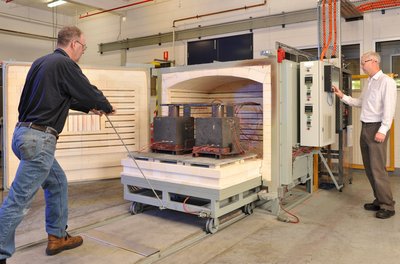CSIRO helps smelters cut energy consumption
Monday, 12 August, 2013
Large smelters in electricity-intensive metal-winning industries can use as much power as a medium-sized city, so finding ways to reduce their energy requirement is a high priority. The Australian research agency CSIRO, in partnership with industry players, is assessing and testing new electrical connection systems in a bid to help smelters cut their electricity consumption and associated emissions.
To assist industry partners in the design and testing process of new electrical connection systems, CSIRO needed to develop a simulation capability that could examine the sophisticated physics involved in the electrical supply infrastructures of large-scale facilities and assess the impact of possible changes. However, because it is both costly and difficult to test new configurations in a functioning facility, engineers used simulation tools to determine whether new designs will work and how to calculate the power savings they will deliver to the operation.
“Modelling and simulation are key tools for future process and design improvement to help our industry improve electrical energy efficiency,” said CSIRO Research Consultant David Molenaar. “An opportunity existed to harness the infrastructure of CSIRO to develop a new, more-advanced modelling solution.”
Essential features of the solution included the ability to assess the performance of electrical connections with respect to energy efficiency in large electrical systems based on the governing physics that is of a fully coupled thermal-electrical-mechanical nature.

The CSIRO team spent 12 months conducting a comprehensive benchmark study that examined all suitable tools available on the market. Performed in partnership with Swinburne University (Melbourne), the benchmarking process incorporated a simple contact problem and a more complex real-world problem. After assessing three potential providers, CSIRO decided to adopt the Dassault Systèmes 3DExperience Platform with the Simulia Abaqus finite element analysis (FEA) application for realistic simulation, through its partner Simuserv, a provider of simulation consulting services.
“The decision to adopt Simulia was based on its ability to solve the fully coupled thermal-electrical-mechanical equations and to achieve convergence in highly nonlinear problems, including complex contact scenarios,” said CSIRO team member Dr Dayalan Gunasegaram. “We also liked its ability to scale and run on our high-performance computing platform.”
Other advantages included the ability of the application to support subroutines that can be used by CSIRO clients in their own installations of the Simulia code. This would allow the team to develop sophisticated modules that clients could then bolt-on to their existing, in-house systems for future testing.
Once the decision to proceed was made, the CSIRO team focused on installing the code on the organisation’s high-performance computing (HPC) architecture. This facility includes a 146 compute node CPU cluster that resides within CSIRO’s HPC facility. The facility also incorporates a GPU cluster with 172,032-streaming processor cores on 384 GPUs, which was ranked 183rd in the world (in November 2012). This vast computing capability, together with the efficient parallel performance of Simulia, allows CSIRO to deliver solutions to clients in short timeframes even when computationally intensive work is required.

With its 3DExperience technology now in place, the CSIRO team has the ability to undertake detailed studies of industrial electrical systems and infrastructures. “We are now receiving calls from clients around the world who are keen to work with us to find more energy-efficient solutions for their operations,” Molenaar said. “With Abaqus on our HPC architecture, we can deliver very accurate results to our clients in commercially relevant timeframes that we simply could not have achieved before.”
The new capabilities meet the overall objectives of CSIRO. While it increases the efficiency of the Australian industry, the application also allows the research organisation to play a valuable part in minimising the environmental impact of energy-intensive industrial activity on a global scale.
With the Simulia-based infrastructure, CSIRO’s clients are able to gain a much clearer view of their energy infrastructure’s performance and make more informed decisions about potential changes. The CSIRO team works to calculate possible performance improvements and cost reductions for each project. The end result is improved energy efficiency and a reduced environmental footprint.
Based on its success with the Simulia application to date, the CSIRO team is planning to extend its usage during the next few years. The networked nature of the software will allow it to be used more broadly within the organisation to run a variety of computationally intensive simulations. As client demand for the services continues to grow, CSIRO anticipates the size of the team will also increase.
“By harnessing tools such as Simulia Abaqus, we are able to compete on a world stage. The support of Dassault Systèmes has been integral to the success of the implementation project and the value that is now being delivered to our clients,” he concluded.
Australia must rethink the foundations of industrial automation
In order to compete globally, we need a willingness to rethink the foundations and build...
IMARC 2025 turns up the innovation spotlight
IMARC 2025 will bring mine owners, operators and contractors together with a line-up of the...
Skills are more critical than ever in today’s AI world
Our increasing reliance on AI to offload cognitive tasks weakens our memorising systems and skills.











